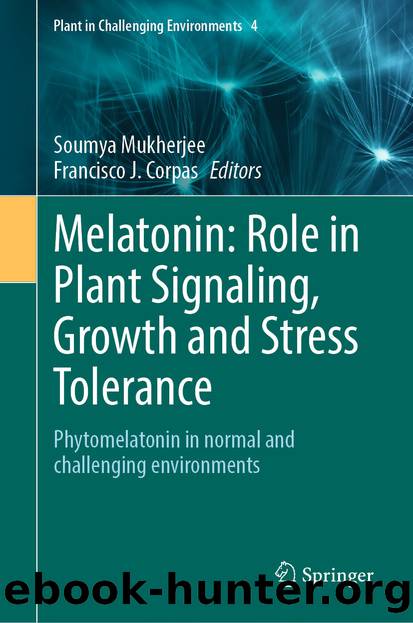Melatonin: Role in Plant Signaling, Growth and Stress Tolerance: Phytomelatonin in normal and challenging environments by Soumya Mukherjee & Francisco J. Corpas

Author:Soumya Mukherjee & Francisco J. Corpas
Language: eng
Format: epub
ISBN: 9783031401732
Publisher: Springer International Publishing
10.5 Conclusion
During postharvest life, fresh horticultural crops suffer from sensory and nutritional quality deterioration accompanied by fungal decay incidence. Low-temperature storage has been employed for delaying senescence and attenuating fungal decay while maintaining the sensory and nutritional quality of fresh horticultural crops. However, chilling injury occurring confines low-temperature storage employed for economically important horticultural crops. Therefore, worthy attempts have been done by researchers for introducing procedures for alleviating chilling injury and fungal decay accompanied by maintaining sensory and nutritional quality in fresh horticultural crops during low temperature storage. In recent years, melatonin gains great attention for employment as a safe eco-friendly procedure for improving the marketability of horticultural crops (Table. 10.1). By tryptophan supplying from the shikimate pathway, TDC, T5H, SNAT, and ASMT expression and activities are responsible for melatonin biosynthesis in the cytosol, chloroplasts, and mitochondria. By melatonin treatment or promoting endogenous melatonin accumulation by triggering TDC, T5H, SNAT, and ASMT expression or suppressing M2H and M3H expression, CAND2/PMTR1 is responsible for triggering melatonin signaling by employing NADPH oxidase-dependent ROS and Ca2+/CaM secondary messengers while promoting CDPK and MAPK signaling pathway. By melatonin signaling, MYB, NAC, bHLH, bZIP, WRKY, HSF, and ERF transcription factors activation could be responsible for marketability responsive genes expression. In addition to transcription regulation, epigenetic DNA methylation, and histone PTMs accompanied by post-transcriptionally microRNAs (miRNAs) employed by melatonin could be responsible for marketability-responsive genes expression. In addition to gene expression regulation, protein PTMs such as phosphorylation, ubiquitination, SUMOylation, nitrosation, and persulfidation could be employed by melatonin for regulating marketability-responsive metabolic pathways. In addition to signaling function, melatonin serves as an amphiphilic molecule with higher intracellular dynamism exhibiting ROS/RNS scavenging cascade. In addition to direct marketability responsive gene expression, melatonin exhibited overlapping with ethylene, cytokinin, abscisic acid, jasmonic acid, salicylic acid, nitric oxide, hydrogen sulfide, strigolactone, brassinosteroids, phytosulfokine α, and extracellular ATP signaling pathways.Table 10.1 Exogenous melatonin application for chilling injury and fungal decay, delaying senescence, and preserving sensory and nutritional quality in horticultural crops during postharvest life
Download
This site does not store any files on its server. We only index and link to content provided by other sites. Please contact the content providers to delete copyright contents if any and email us, we'll remove relevant links or contents immediately.
Whiskies Galore by Ian Buxton(41880)
Introduction to Aircraft Design (Cambridge Aerospace Series) by John P. Fielding(33064)
Rewire Your Anxious Brain by Catherine M. Pittman(18553)
Craft Beer for the Homebrewer by Michael Agnew(18140)
Cat's cradle by Kurt Vonnegut(15186)
Sapiens: A Brief History of Humankind by Yuval Noah Harari(14252)
Leonardo da Vinci by Walter Isaacson(13184)
The Tidewater Tales by John Barth(12608)
Thinking, Fast and Slow by Kahneman Daniel(12079)
Underground: A Human History of the Worlds Beneath Our Feet by Will Hunt(12024)
The Radium Girls by Kate Moore(11921)
The Art of Thinking Clearly by Rolf Dobelli(10223)
A Journey Through Charms and Defence Against the Dark Arts (Harry Potter: A Journey Throughâ¦) by Pottermore Publishing(9232)
Mindhunter: Inside the FBI's Elite Serial Crime Unit by John E. Douglas & Mark Olshaker(9201)
Tools of Titans by Timothy Ferriss(8218)
Wonder by R. J. Palacio(8010)
Turbulence by E. J. Noyes(7936)
Change Your Questions, Change Your Life by Marilee Adams(7635)
Nudge - Improving Decisions about Health, Wealth, and Happiness by Thaler Sunstein(7615)
